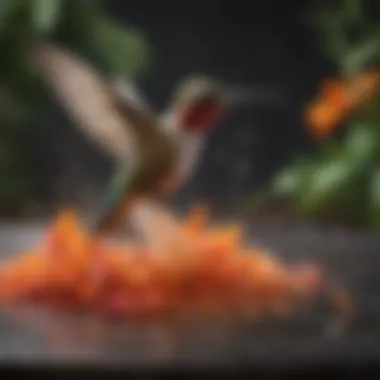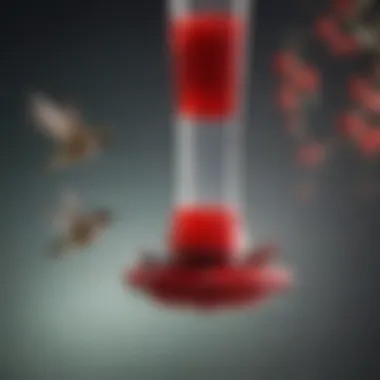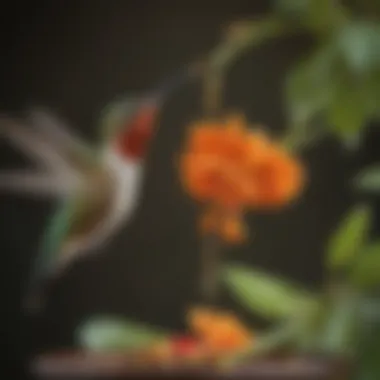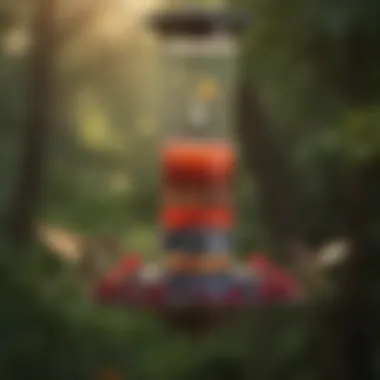Crafting the Perfect Hummingbird Feed: A Complete Guide


Intro
Creating hummingbird feed is not just a hobby; it's a way to connect with nature and support local wildlife. Hummingbirds are fascinating creatures, known for their rapid wing beats and astonishing agility. By providing them with a reliable source of food, you not only attract them to your garden or balcony but also contribute to their well-being. This guide serves as a comprehensive tool for anyone looking to make high-quality hummingbird feed at home.
Understanding the basic recipe, the ingredients, and the preparation methods is crucial. While the process is reasonably straightforward, attention to detail ensures the best results. It is also important to consider variations and best practices to keep the feed fresh and appealing. This article will delve into every aspect of preparing hummingbird feed, making it suitable for both newcomers and seasoned birdwatchers.
Prelude to Hummingbird Feed
Hummingbirds are not just vibrant additions to gardens and backyards; they play a crucial role in pollination. To attract and sustain these captivating creatures, it is vital to offer them the right nutrition. Creating hummingbird feed at home is both simple and rewarding. This section outlines the essential aspects of hummingbird feeding.
Understanding Hummingbird Diet
Hummingbirds primarily feed on nectar from flowers, which provides them with necessary sugars and energy. However, their diet is not just limited to nectar. They also consume insects and spiders for protein, vitamins, and minerals. This balanced diet is crucial to their survival and wellbeing. Providing a proper nectar blend replicates the natural sources of nutrition that they seek in the wild.
Moreover, some hummingbird species migrate long distances in search of food, making reliable feeding sources critical. If a feeder offers a suitable nectar solution, it helps them replenish their energy reserves, supporting their migratory journey. By understanding their dietary needs, one can better appreciate the importance of feeding them effectively.
Importance of Providing Feeders
Installing hummingbird feeders is essential for attracting these birds to your space. While flowers can provide nectar, feeders ensure a constant supply of food. This becomes especially significant during migration periods when food sources are scarce. Feeders can supplement their diets and help them thrive in urban and suburban environments where natural nectar sources might be limited.
Some key advantages of providing feeders include:
- Consistent Food Supply: Feeders provide a reliable food source, especially during periods of scarcity.
- Encouraging Local Wildlife: By attracting hummingbirds, gardeners contribute to local biodiversity, benefiting other pollinators too.
- Aesthetic Appeal: Hummingbird feeders can enhance the visual beauty of gardens, providing enjoyment to viewers and observers alike.
Consider the type of feeder and its placement carefully. These factors influence the likelihood of attracting hummingbirds. Proper feeders positioned in suitable locations can transform ordinary gardens into vibrant hotspots for these remarkable birds.
"Providing food for hummingbirds helps strengthen the ecological balance in urban areas, allowing these pollinators to flourish."
In summary, feeding hummingbirds is an easy yet impactful way to engage with nature. Knowing their diet and the importance of feeders is the first step in supporting these unique birds.
Essential Ingredients for Hummingbird Feed
The creation of hummingbird feed is centered around a few essential ingredients. Each element plays a critical role in attracting these remarkable birds while providing them with the nutrition they need. Understanding these ingredients can help ensure you prepare feed that not only appeals to hummingbirds but also mimics their natural diet. This section will detail the significance of granulated sugar and water, emphasizing their unique properties and contributions to hummingbird health.
Granulated Sugar
Granulated sugar is the primary ingredient in homemade hummingbird feed. It serves as a source of energy for these tiny, active birds. Hummingbirds require high levels of sugar in their diet because their metabolism is incredibly fast. The quick energy from sugar supports their relentless flapping of wings and overall high activity levels.
Choosing the Right Sugar
It is crucial to use pure granulated sugar, as it lacks additives that may be harmful. Avoid using brown sugar, honey, or artificial sweeteners. These alternatives may not provide the same benefits and could negatively impact hummingbirds' health.
To prepare the feed, a common recipe suggests mixing one part sugar with four parts water. This ratio achieves a sugar concentration similar to that found in natural flower nectar, providing an optimal balance for hummingbirds.
Water
Water is just as important in making hummingbird feed. It acts as a solvent for granulated sugar, allowing it to dissolve completely and create a nutritious nectar. Additionally, hummingbirds need access to freshwater for drinking and bathing. Having clean water sources nearby can attract them to your feeders even more.
Preparation of Water
When preparing the feed, it's essential to use clean, filtered, or boiled water to eliminate any harmful contaminants. Tap water could sometimes contain chlorine or other substances unsuitable for hummingbird consumption. Allow the water to cool before mixing it with the sugar to prevent any potential degradation of nutrients.
In summary, the two essential ingredients for hummingbird feed are granulated sugar and water, both crucial for supporting the energy needs and health of these unique birds. Ensuring proper selection and preparation of these ingredients sets the foundation for a successful feeding experience.
Preparing Hummingbird Feed


Preparing hummingbird feed is a crucial step in ensuring that these delicate and energetic creatures receive the nutrients they need. It can easily be done at home, saving you money and allowing you to control the quality of the ingredients used. The preparation process should be done with great care to ensure the ratios and methods are appropriate. Hummingbirds rely heavily on sugars for energy, and proper feed preparation will help attract them to your yard while keeping them healthy.
Mixing Ratios
The ratio of sugar to water is the primary consideration when preparing hummingbird feed. A common recommendation is to use a four-to-one ratio of water to sugar. This means for every four cups of water, you will use one cup of granulated sugar. This ratio closely mimics the natural nectar that hummingbirds find in flowers, making it more appealing to them.
When mixing the solution, it is important to ensure that the sugar is completely dissolved. Here’s how to properly prepare the mixture:
- Measure the water in a clean container.
- Add the granulated sugar according to the desired ratio.
- Stir the mixture vigorously until the sugar is fully dissolved. This may take a few minutes.
- Allow the mixture to cool if heated to help dissolve sugar faster, but keep in mind that heating is not necessary.
Using precise ratios helps to avoid feeding hummingbirds a solution that is either too diluted or overly sweet. The latter can lead to unhealthy conditions if they ingest too much sugar.
Cooking vs. Raw Preparation
There is a debate regarding whether to cook the sugar-water mixture or to prepare it raw. Both methods have their proponents, but each has distinct benefits.
Cooked preparation involves briefly boiling the water before adding sugar. This process can help to sanitize the mixture, eliminating any potential impurities present in the water. Moreover, cooking helps dissolve the sugar more effectively, creating a clear liquid that is easy to see through the feeder. Additionally, if your local water has a high level of chlorine or contaminants, boiling can help remove them.
However, raw preparation is more straightforward and quick. Simply combining sugar and water at room temperature can save time, making it suitable for those who are busy. It's essential to ensure that the water used is clean and free of chlorine. If you opt for raw preparation, always make sure to clean your feeders regularly to prevent any buildup or bacteria.
Ultimately, both methods can be effective for preparing hummingbird feed. The choice largely depends on personal preference and circumstances. Monitoring how hummingbirds respond to the food will further guide you on which method produces the best results.
Remember, keeping feeders clean and providing fresh nectar regularly is key to attracting hummingbirds effectively.
Variations of Hummingbird Feed Recipes
Understanding variations of hummingbird feed recipes is essential for any bird enthusiast aiming to attract a diverse array of hummingbirds. Different species of these birds may prefer different types of food, and their diet can vary based on their habitat and available resources. Therefore, providing a range of feed choices is crucial to support their nutritional needs.
Moreover, some variations can address specific challenges, like attracting birds during certain seasons or avoiding unwanted insects. Knowing these alternatives allows you to adapt your feeding strategies, thus maintaining a thriving hummingbird population visiting your yard or garden.
Natural Nectar Alternatives
Natural nectar alternatives serve as an excellent way to provide hummingbirds with nutrition derived from their native environments. These options can be made using fruits or sugars found in flora that hummingbirds may encounter in the wild. Here are some common alternatives:
- Fruit Juice Mixtures: Dilute pure fruit juices, like orange or grapefruit juice, with water. This can mimic the natural sources hummingbirds would find in their habitats.
- Flower Extracts: Prepare infusions from plants and flowers known for attracting these birds. For example, steeping hibiscus or honeysuckle in boiling water can yield a sweet nectar-like solution.
- Honey Water: In some cases, a diluted honey mixture can be a good substitute; however, it must be used with caution. Too much sugar can be harmful to hummingbirds.
When using natural alternatives, always ensure they are free of additives and preservatives. For instance, if using fruit juice, make sure it contains no added sugars. Also, these alternatives tend to ferment quicker than traditional sugar water, so replacing them regularly is a must.
"Natural options are not only healthier but also can create a more engaging environment for the birds."
Commercial Hummingbird Feed
Commercial hummingbird feed offers a convenient and often effective solution for those who may not have the time to create homemade versions. These products are specifically formulated to meet the nutritional needs of hummingbirds while eliminating some common issues associated with DIY nectar mixes. Here are some aspects to consider:
- Consistency in Nutritional Content: Commercial feeds often come with nutritional guarantees. They are specifically designed to provide the right balance of sugar that mimics natural flower nectar.
- Easy Preparation: Many commercial products require little to no preparation. Simply mix the powder with water according to the instructions, making it an easy option for busy bird lovers.
- Special Formulations: Some brands offer specialized mixes that target specific hummingbird species or cater to seasonal dietary needs.
However, it is crucial to read labels carefully. Look for products that do not contain dyes or artificial additives. Brands like Bird’s Best and Kaytee are popular and regarded as safe choices for hummingbird feeding needs.
By providing both natural alternatives and commercial feeds, you can create a versatile feeding area that caters to different varieties of hummingbirds, ensuring they receive the right nourishment throughout the year.
Feeder Selection and Maintenance


The success of attracting hummingbirds largely depends on selecting the right feeder and maintaining it in optimal condition. Proper feeder selection ensures that the birds can access nectar easily, promoting more visits. Additionally, regular maintenance prevents contamination and prolongs the lifespan of your feeder. This section will explore the critical factors to consider in feeder selection and the best practices for keeping those feeders clean.
Choosing the Right Feeder
When looking for a hummingbird feeder, there are several factors to consider. First, you want to choose a feeder that has a suitable design to accommodate various hummingbird species. Feeders with bright colors, especially red, naturally attract these birds.
The capacity of the feeder matters, too. A larger capacity feeder is suitable for avid hummingbird enthusiasts who wish to attract more birds, while smaller feeders work well for those with limited space or fewer birds visiting.
Additionally, consider the feeder's construction material. Glass and durable plastic are common choices. Glass feeders tend to be more robust and aesthetically pleasing, while plastic feeders can be lighter and easier to handle.
Ultimately, the best feeder allows for easy access to nectar while minimizing bee and wasp contamination.
Cleaning Protocols
Proper cleaning of your hummingbird feeder is crucial for the health of the birds that visit it. It helps to prevent the growth of mold and harmful bacteria, which can endanger hummingbirds. The cleaning process should be straightforward and conducted regularly.
Frequency of Cleaning
When it comes to frequency of cleaning, it is recommended to clean feeders at least once a week during peak feeding season. In hotter weather, reducing this interval is prudent, as nectar can ferment quickly.
This routine contributes significantly to the overall health of the hummingbirds. Clean feeders not only protect the birds from diseases but also ensure that they receive fresh nectar that is appealing and safe. The ease of incorporating this practice makes it a popular choice among bird watchers, as it takes little time yet yields significant rewards.
Cleaning Solutions
For cleaning solutions, many opt for a simple mixture of warm water and mild soap. This combination is effective in removing residue without leaving harmful chemicals behind. Some people use white vinegar as a natural disinfectant, which helps eliminate any bacteria or mold growing inside the feeder.
Using simple, non-toxic cleaning solutions is beneficial because they do not pose any risk to the birds. However, avoid using bleach or harsh chemicals, as these can be dangerous. The main goal is to ensure a sanitized feeder without compromise, promoting the health of your cherished hummingbirds.
Best Practices for Attracting Hummingbirds
To successfully attract hummingbirds, understanding their behaviors and needs is crucial. These small birds are drawn to feeders primarily by their need for sustenance during the warmer months. Implementing best practices not only increases feeding activity but also promotes a healthy environment for these birds. Factors like feeder placement, seasonal adjustments, and maintenance play vital roles in ensuring that your efforts yield results.
Optimal Placement of Feeders
Placing hummingbird feeders in the right location is essential for visibility and accessibility. Hummingbirds are curious and will explore feeders placed in open, sunny areas. Feeders should be positioned where they can be easily seen from a distance. Recommended spots include:
- Near flowering plants that attract hummingbirds.
- Areas protected from strong winds.
- Places that minimize potential obstruction by branches or other objects.
Moreover, positioning feeders near windows can enhance the chance of observation without seeming alarming to the birds. The combination of sun exposure helps in warming the nectar, making it more tempting.
Seasonal Considerations
Migration Patterns
Migration patterns are a significant aspect to consider when attracting hummingbirds. Many species travel long distances between breeding and wintering grounds. Understanding when these migrations occur can help determine the best times to put up your feeders.
- Key Characteristic: Most hummingbirds migrate alone rather than as part of a flock, making them more individualistic in their behavior. This characteristic influences their feeding habits and preferences.
- Advantage: By setting up feeders in advance of the migration, you can catch the attention of migrating birds that are looking for sustenance along their route. This is especially true in regions where consistent food sources may be limited.
Temperature Effects
The effects of temperature are important for optimizing the feeding experience for hummingbirds. As temperatures change, so do the feeding habits of these birds. Cold or excessively hot weather can affect their nectar consumption.


- Key Characteristic: Nectar has a higher sugar content in warmer weather, making it more appealing to the birds. When temperatures drop, the natural flowers they rely on may have less available nectar, increasing their reliance on feeders.
- Advantage: During periods of extreme temperatures, having a consistent source of feed available can provide essential nutrients. Consider adjusting the sugar-to-water ratio in your feeders based on the season to provide a more energy-dense nectar when needed.
Remember: Regularly observe and adjust your practices based on the birds' behavior and environmental changes for continued success.
Common Challenges and Solutions
Creating and maintaining a hummingbird feeding station is rewarding. However, some hurdles can arise. Addressing these challenges is crucial. By understanding the common issues, one can ensure a thriving environment for these birds and improve the overall feeding experience.
Ants and Other Pests
Ants can be a significant problem for hummingbird enthusiasts. These pests are attracted to the sugar solution. They may invade feeders, make it difficult for hummingbirds to access the nectar. It's important to keep feeders clean and check for leaks. Leaking nectar not only attracts ants but also creates a breeding ground for other pests.
To deter ants, choose feeders designed with ant moats. These are small reservoirs filled with water that create a barrier. You can also coat the feeder hangers with petroleum jelly. This simple trick prevents ants from climbing up. Alternatively, place the feeder in a location where ants are less likely to have access. Regular monitoring is vital.
Feeder Damage or Leakage
Damage to feeders can affect their functionality. Leakage is a common issue. It can lead to the waste of nectar and attract unwanted pests. Damage often occurs from weather exposure or mishandling. Using high-quality feeders reduces the likelihood of such issues. Consider materials like glass or durable plastic that withstand elements.
If a feeder does leak, check the seals and connections. Sometimes, tightening parts or replacing worn components fixes the problem. For plastic feeders, inspect for cracks. A quick repair with food-safe adhesive may extend its life. Regular maintenance prevents major problems.
"By staying vigilant and proactive about challenges, we can create a safe and inviting spot for hummingbirds, ensuring they thrive in our gardens."
In summary, dealing with ants and feeder damage can be manageable with the right strategies. Knowing these aspects is essential for a fruitful hummingbird feeding experience.
Safety Considerations
When engaging in the process of making hummingbird feed, safety is paramount. This section will address the vital components of ensuring that feeders are safe for these delicate birds. Understanding toxic substances and monitoring for diseases in feeding sites will preserve both the health of the hummingbirds and the overall enjoyment they bring to your garden or backyard.
Avoiding Toxic Substances
Hummingbirds are particularly vulnerable to toxic substances. The common ingredients used in hummingbird feed, primarily granulated sugar and water, are generally safe. However, it is essential to avoid any additives or preservatives that might be harmful. This includes:
- Artificial Sweeteners: Avoid using sweeteners like aspartame or sucralose as they can be lethal to hummingbirds.
- Coloring Agents: Many commercially available hummingbird feeds have artificial coloring. These dyes can be harmful to birds. Stick to pure sugar water to minimize risk.
- Pesticides and Chemicals: Ensure that no pesticides, herbicides, or chemical fertilizers have been used in or near your feeder area. These substances can contaminate the nectar and pose serious health risks.
Maintaining a clean environment around feeders also contributes to safety. Regularly inspect and clean feeders to prevent harmful mold or bacteria build-up. By implementing these protocols, you are creating a safe haven for hummingbirds.
Monitoring for Disease
Regular monitoring of feeders and surrounding areas is crucial in preventing disease among hummingbird populations. Hummingbirds can succumb to illnesses that spread through contaminated nectar and feeders, which can result in significant declines in their numbers. Here are some considerations:
- Identify Symptoms: Keep an eye out for sick birds. Symptoms may include lethargy, ruffled feathers, or difficulties in flight. Noticing these signs early can prompt immediate action.
- Regular Cleaning: Adhere to a strict cleaning schedule. Use hot, soapy water to clean feeders at least once a week. During hotter months, more frequent cleaning may be necessary.
- Report Observations: If you see multiple birds showing symptoms of disease, such as a high number of sick or dead birds in your area, contact local wildlife authorities. They might offer guidance based on the specific type of illness reported.
Monitoring for disease not only helps protect the hummingbird community, but also enhances your experience as a feeder keeper. By ensuring that your feeding practices prioritize well-being, you foster a more dynamic and healthy environment for these magnificent creatures.
Remember: A clean feeder is a happy feeder. Always prioritize safety in your feeding practices.
Ending
Recap of Key Points
- Ingredients: The primary components for hummingbird feed are granulated sugar and water, which form a basic nectar substitute.
- Preparation Method: Mixing the correct ratio of sugar to water, typically a one-to-four ratio, ensures that the feed is sweet enough to attract hummingbirds.
- Feeder Care: Regular cleaning is necessary to prevent mold and disease, with distinct cleaning protocols like using a diluted vinegar solution.
- Variations: For those interested, there are natural nectar alternatives and commercial brands available, providing options depending on personal preference or supply access.
Encouragement for Ongoing Engagement
Engaging with hummingbirds offers a rewarding experience, whether through personal feeding efforts or community initiatives. Maintaining the feeders regularly and observing these birds can provide profound joy. Individuals are encouraged to share their experiences, whether that be via social platforms like Facebook or community forums on Reddit.
Learning from each other's encounters not only enriches personal understanding but also promotes conservation efforts for hummingbird habitats. As enthusiasts, staying informed about changing migration patterns and seasonal behaviors can enhance the overall hummingbird-watching experience. It's vital to stay dedicated to the process, as every little effort contributes to the well-being of these exquisite creatures.







